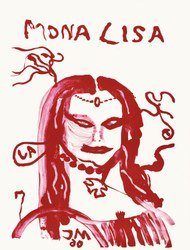JONATHAN MEESE. MOST TOTAL GRAPHIC ART
Opening hours from Thu-Sun, 10 am to 6 pm, free access
Special opening hours:
09.04.2012 (Easter Monday)
01.05.2012 (National Holiday)
Exhibition concept: Jonathan Meese, Ruth Lackner, Björn Egging
Opening: March 15, 2012, 6:00 p.m.
With Andrea B. Braidt, Vice-Rector Art | Research, and
Björn Egging, Director of the Lyonel Feininger Gallery Quedlinburg
With a performance by Jonathan Meese: DER NON-NOSTALG "MEESEVOLUTIONÄR" SPRICHT: DIE BURSCHNS GESTATTNS A EVOLUTIONUSSNS
An exhibition of the Lyonel Feininger Gallery Quedlinburg realized in conjunction with the Academy of Fine Arts Vienna
Jonathan Meese, born in Tokyo in 1970, ranks among today's most colorful German artists. Extensive, obsessive, and radical, his oeuvre shows a definite actionist character. Bringing his body into play without restriction and employing all media, Meese combines painting, drawing, and sculpture with collages, texts, and collections of material to sprawling installations resembling towering piles of high art and trash. Each of his statements - which oscillate between provocation, blasphemy, catharsis, exorcism, and criticism of the political system - is art and only seemingly pretentious and insolent. Meese rather follows in the tradition of the Dadaists who regarded the "mumblings of lunatics and children" and nonsense as the only way back to elementary truths: art is a child's game in the true sense of the word to be attained with nothing less than a complete change of system from "democracy or some other form of government made by people" to the "dictatorship of art."
In Meese's utopia of the liberation from all ideology and art assuming power, an ironically eloquent cultural pessimism converges with the highest aim of the classical avant-gardes: to bring art and life together. Particularly in his texts and performances, Meese relies on an unparalleled radicalization, uses the rhetoric repertoire of twentieth-century dictatorships - especially of National Socialism - for his purposes, and reduces their vocabulary and gestures to the absurd when he propagates the ideal of "total art." He does not claim the role of dictator for himself - "With art in power I'll be gone, too" - but rather that of the tireless "ant of art."

Three-color etching with aquatint and monotype, 49.2 x 49.7 cm
(76 x 53.5 cm)
Photograph: Rosi Radecke, Hannover
© VBK, Vienna 2012
Jonathan Meese has made approximately one hundred prints, either as single sheets or for portfolios, since 2003. The mostly large-format lithographs, etchings, and woodcuts are portraits of characters from history, mythology, and pop culture, or imaginary figures, which, in their graphic reduction, turn into symbols of art history and the artist's alter ego. In his universe, historical and mythological figures share the same reality: power people like Emperor Nero, Wagner, Nietzsche, or Hitler, heroes of state such as Hagen von Tronje or Saint-Just - a symbolic figure of many generations and one of the inventors of an exaggerated centralization of power - as well as villains from James Bond novels are taken apart, reassembled, and "mashed," as the artist aptly notes. In comparison with other works, the production of images in Meese's concentrated, expressive prints strikes us as more eruptive and ecstatic. It is especially the technique of lithography that best accommodates his way of working by allowing him to draw quickly on stone. "What's direct and fast suits me because it's the most radical," is how Meese explains the connection between the graphic form and his artistic intentions. "In most cases you don't get more precise when you work longer on something, polishing it."

Two-color etching with drypoint on two-color linocut, 49.5 x 35 cm
(65.5 x 50 cm)
Photograph: Griffelkunst-Vereinigung Hamburg e. V.
© VBK, Vienna 2012
Graphic simplification, the artist says, is aimed at "the face of the predator," the precise elaboration of the "primal geometric form" underlying all things. This is why the concept "graphic" does not relate to graphic works only, but describes Meese's method to obtain a brief, precise statement. The artist is hardly interested in the conceptual potential of the last fifty years' achievements in printmaking: "It can't be a matter of a technical extension of anything. Within the limits of what you're doing you have to create maximum precision." The old techniques turn into experimental and energy-charged expressive supports for Meese's THE MOST TOTAL GRAPHIC ART, leaflets, share certificates for "the dictatorship of art" - and, possibly, the quintessence of his artistic ideas.
Didactic program (in German): " TOTALSTE VERMEESUNG ,"
as of March 23, 2012
Developed and organized by Julia Hay, Heike Jooß, Claudia Lomoschitz, Katharina Luksch, Karoline Maisch, and Natascha Muhic, Academy of Fine Arts Vienna, as well as Ulrike Davis-Sulikowski and Igor Eberhard, Institute of Cultural and Social Anthropology, University of Vienna

Three-part two-color lithograph, 69.5 x 99 cm,
Photograph: Rosi Radecke, Hannover
© VBK, Vienna 2012
List of entries
-
JONATHAN MEESE. MOST TOTAL GRAPHIC ART
Opening hours from Thu-Sun, 10 am to 6 pm, free access
Special opening hours:
09.04.2012 (Easter Monday)
01.05.2012 (National Holiday)
Exhibition concept: Jonathan Meese, Ruth Lackner, Björn EggingOpening
1st floor
Academy





